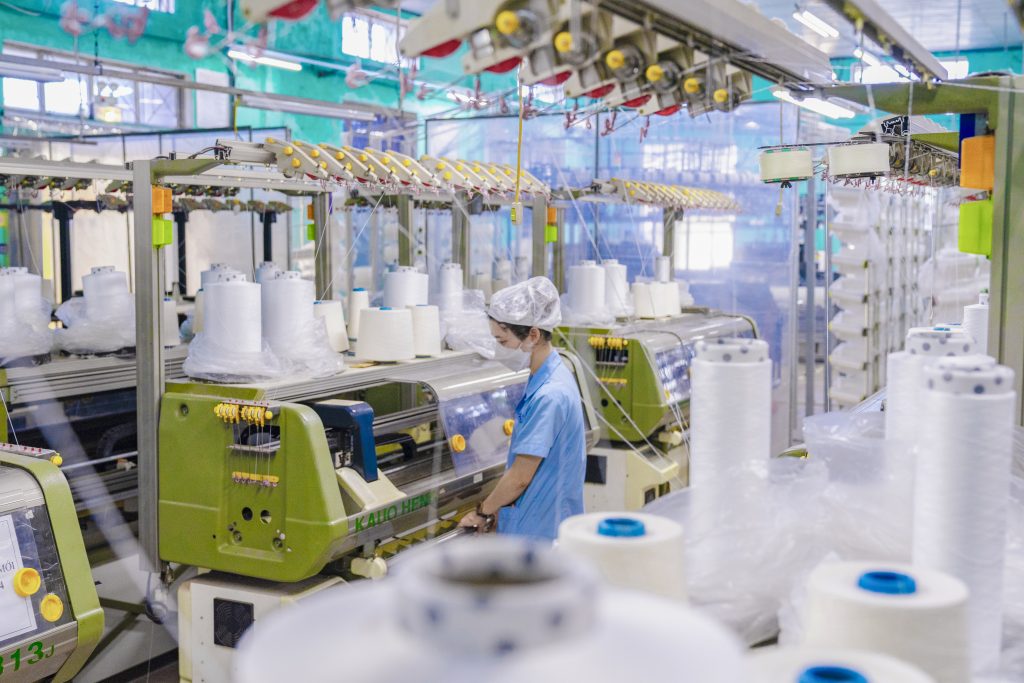Each business has its own direction to reach their goals, despite the fluctuations of 2024
As the market in 2024 is expected to remain unpredictable, Vinatex and its member companies have each devised their strategies and solutions to achieve their annual targets. One such solution involves venturing into niche markets, such as the production of flame-retardant fabrics, to increase product value. To gain deeper insights into the opportunities and challenges facing the textile industry in this new context, as well as Vinatex’s strategy for producing flame-retardant fabrics, Vietnam Textile Garment & Fashion Magazine interviewed Mr. Le Tien Truong, Chairman of the Board of Directors of Vinatex.

“Big ships, big waves”
Interviewer: Vietnam’s textile-garment industry is currently ranked third globally in export turnover. Many believe that this places significant pressure on the industry, given the recent market difficulties. Could you share what is the biggest pressure and the current production of textile garments in the early months of 2024, sir?
Le Tien Truong, Chairman of Vinatex: “Big ships, big waves”—with an export scale ranking third in the world, employing over 2 million workers, and monthly export turnover needing to reach $3.5 to $4 billion, it is clear that the global market and economic impacts on Vietnam’s textile garment exports are substantial. The biggest challenge for a labor-intensive industry is always ensuring jobs and income for workers.
In the early months of 2024, the market showed some signs of improvement. On the positive side, we see a clearer trend of soft landing of the world economy. However, stringent financial policies in various countries to ensure this soft landing have also restrained the demand for textiles from increasing as usual.
In 2023, overall textile garment demand decreased significantly. In the best scenario, demand in 2024 is forecasted to only increase by less than 3%. In fact, after the first six months of 2024, total demand is still down by about 5% compared to 2023, which is approximately 7% lower than in 2019 – the year before the COVID-19 pandemic. This means that global demand has not fully recovered to pre-pandemic time.
Interviewer: Unit prices remain stagnant, and revenues and profits have not met expectations. How do you assess the goal of reaching $44 billion in exports this year?
In the first seven months of 2024, Vietnam’s textile garment industry is likely to export $23.8 to $24 billion, with seeing export turnover of $4.2 to $4.3 billion in July—the highest monthly export volume since August 2022. This represents a growth rate of about 6% over the seven months, with apparel exports reaching $20.3 billion, a 6.3% increase; yarn exports at $2.5 billion, a 3.5% increase; technical & cord fabrics at around $460 million, an 18% increase; and textile garment materials at over $800 million, an 11% increase.
The five main export markets for Vietnam’s textile garment have all shown growth in the first 6 months compared to the same period last year: the US market reached $7.4 billion (up 3.1%), Europe $2 billion (up 0.8%), Japan $1.97 billion (up 4.9%), South Korea $1.65 billion (up 2.6%), and China $1.68 billion (up 4.6%). Additionally, ASEAN became a new “billion-dollar” export market with about $1.5 billion in the first six months. By the end of this year, Canada is also expected to reach $1 billion in exports, having already hit $580 million in the first half. This means that by the end of the year, Vietnam is likely to have seven export markets exceeding $1 billion, with the US market still striving to reach $15-16 billion this year.
The goal of $44 billion in exports for 2024 requires a 10% growth over 2023. Reflecting on the first six months of 2023, Vietnam performed relatively well, even in the last August, it was expected to reach the last peak at $4 billion. However, the last four months of 2023 fell into crisis, with the peak export season only achieving around $3.1 to $3.2 billion per month. In total, it gained only $13 billion from September to December, compared to $16 billion in 2019. The $44 billion export target will depend much on market movement in the fourth quarter of 2024. If the growth is as recent, with exports reaching around $4 billion per month, we will achieve the goal.
However, in my experience, long-term forecasts of 6 months to a year have proven to be highly inaccurate since 2022. Therefore, the biggest challenge for Vietnam’s textile garment industry today is the uncertainty in market forecasts. We may experience very good months, followed by 1-2 months of severe downturn. The market fluctuations since 2022 have taught textile garment industry managers that they must always have shorter, more up-to-date forecasts, and make quicker, more flexible management decisions if they want to capture the short-term growth waves in the global market.
Interviewer: Could you provide an update on the current status of orders?
As of July 2024, the order situation for many units is quite positive. Vietnam is the only country among the four largest textile garment exporters in the world that has seen its market share increase in key markets. In the US, the market share of Vietnam increased from 17.6% to 18.3%, making us the top market share holder, equal to China. Meanwhile, Bangladesh’s market share decreased by nearly 1% to 9.8%, and India remained flat at 7%. In Europe, although textile garment imports fell by about 5.5%, Vietnam’s textile garment exports maintained a market share of around 4.4%. Vietnam is the only country that has stable growth.

So far, August orders are also looking positive, potentially better than July. September may see a slight dip as it is a seasonal transition month, but orders for October, November, and December are expected to be relatively abundant, though still depend heavily on macroeconomic fluctuations in importing countries.
Currently, macroeconomic conditions and inventory of fashion brands are showing positive signals for orders in the last five months of the year. With low inflation in the US and the possibility of a Fed interest rate cut in September, and perhaps another rate cut by the end of the year, opening up the opportunity for demand increase. The UK’s interest rate has had a second decrease since March 2020 on August 1 with a 0,25% decrease. Thus, it is hoped that the demand will increase when cutting interest rates. Additionally, major fashion brands have significantly reduced their inventories in Q2 2024, with Nike reducing by 11% and Levi’s by 7%. The business performance of fashion brands has shown relatively sustainable improvement, with standout profit growth from H&M (about 49%) and Uniqlo (about 36%). With fashion brands’ profits increasing, we hope that order prices for manufacturers like us will improve. However, over the past seven months, prices for orders have remained low; although orders are abundant and production is better organized, the prices for individual orders have not improved, and some are even lower than in 2023. On the foundation of sufficient orders, most textile garment enterprises are seeing better performance compared to 2023.
From a management perspective, having orders is considered a necessary condition to maintain operations, retain customers, and sustain market share and workforce, allowing us to seize growth opportunities. However, from a financial perspective, it is important to recognize that profitability has not improved due to lower unit prices compared to 2023. To have the profits as in 2021—the first year after the pandemic, with a surge in demand and a leap in business performance—will be challenging to achieve in 2024.
Improving productivity per capita
Interviewer: What solutions does Vinatex have to address these current challenges?
The development of the textile garment industry occurred when the country was still underdeveloped, with low income and abundant labor. As a result, the industry initially relied on cheap labor advantage to access markets. As we have transitioned from a low-income middle-income country with a vision to upper-middle income, the competitive advantages based on low labor costs are no longer effective. Not just Vinatex, but all domestic textile garment enterprises have recognized this weakness and need to make changes to adapt to new conditions.
In my view, the first change should be to improve productivity per capita which determines workers’ income. To address this issue, enterprises need to invest in and utilize high levels of automation, reducing the number of workers required per product, while also seeking niche products with higher value to increase the value of labor per hour. All solutions within the Vinatex system are geared towards this goal. In addition to automation, the labor costs in some material production sectors have been reduced by 60% per product, ensuring wage increases for workers.
In the garment sector, all stages requiring high skill levels and bulk orders have been automated. For example, previously, to achieve an additional $1 billion in revenue, 100,000 additional workers were needed. Now, to achieve the same growth, only about 20,000-30,000 workers are needed. In addition to the general solution, which requires investment in technology, productivity increases, and automation, as well as a shift towards higher-value products, each enterprise will have its unique approach. Nearly 40 member units of Vinatex have different approaches and niche markets; they do not all focus on the same products. Some enterprises will target very specialized products and niche markets that, although small, offer significant returns, such as specialized technical fabrics and high-quality textiles—products that are distinct from common fashion fabrics.
Interviewer: Speaking of high-value products and niche markets, does Vinatex have any new products?

Currently, Vinatex has begun researching and successfully producing industrial fabrics for specific requirements. Vinatex has formed a joint venture with Coats Group, a partner that has collaborated with Vinatex’s member company (Phong Phu Corporation) for 35 years in producing sewing thread, embroidery thread, and footwear thread. Recently, Vinatex and Coats have partnered to invest in the production of fire-retardant fabrics. Unlike current coating technologies, this fabric is produced from fire-retardant, low-flammability, and non-flammable fibers. This product requires high technical standards, legal compliance, and intellectual property rights, and it is not an ordinary fashion fabric. It can be compared to medical treatment drugs in the healthcare industry, with specific production regulations, patents, and copyrights.
Recently, Vinatex has been rapidly producing these fabrics, and the first orders are expected to be exported to Indonesia, India, the Middle East, and the United States in the second and early third quarters of this year.
This is a product evaluated, set standards for, and decided to use by various countries. These fire-retardant clothes are used in various technical industries, such as oil and gas, electricity, and residential buildings that require fire-retardant curtains and products to prevent fire hazards. Products made from these fabrics are not commercially available in global supermarket systems but must strictly comply with the standards and regulations of the importing countries. We have already received evaluations and approvals from the U.S. market. This product has the potential for rapid growth, but its success will depend on the policies of each country. It is a unique product that is different from one produced in the past.
In this collaboration, our revenue target for 2024 is $2-$2,5 million, intending to double that growth annually over the first five years. The initial focus is on meeting the requirements of the U.S. market—a very important market for the global textile garment industry. Success in the U.S. market will facilitate entry into the EU, Japan, South Korea, and other markets worldwide. While it is too early to predict the long-term success of this new product that Vinatex is developing and producing for the first time, compared to other common products, the growth potential for fire-retardant fabric is clearer and faces less competition in the market. The outcome will depend on the target users of this technology and Coats Group.
Interviewer: How is Vinatex adding value to its existing strong product lines?
In addition to fire-retardant fabrics, Vinatex is also focusing on adding value to certain yarn products. Previously, most fabrics were produced from cotton, but now about 70% of fabrics are produced from synthetic fibers, natural fibers, etc. Vinatex has started producing yarns with diverse properties and multiple components within a single yarn, using complex technologies and techniques to support the production of special fabrics.
In the fashion textile industry, the area of materials and material technology is the most creative. Vinatex has introduced innovations in the garment sector, creating designs that reflect the colors and sizes of the Vietnamese for the domestic market. Additionally, Vinatex is developing the garment sector, from the sewing process to fashion design technology, transforming artistic ideas into design concepts, determining prices, technology, and materials, and organizing production to offer a complete design package to partners. This approach also changes the quality of the workforce in textile garment enterprises, moving beyond simple labor to high-quality labor for high-value-added production areas, compensating for traditional production and increasing labor productivity per capita
